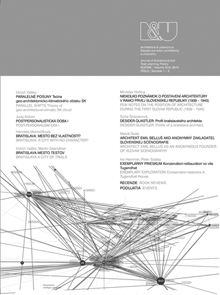Desider Quastler: Profil bratislavského architekta
Desider Quastler: Profile of a Bratislava architect
Author(s): Soňa ŠčepánováSubject(s): Cultural Essay, Political Essay, Societal Essay
Published by: Historický ústav SAV, v. v. i.
Keywords: Architect; 20th century; work; modern; residential buildings; villa; Jewish
Summary/Abstract: Alongside more prominent personalities, the interwar architectural scene in Slovakia was no less shaped by thus far scarcely recognized names. Architect Desider Quastler belongs among them. After almost two decades of endeavour as a successful architect, he left behind an extraordinary scope of work, some of which is an integral part of the image of present-day Bratislava. Quastler came from a large Bratislava jewish family. After completing a construction trade school in Budapest, he was employed in a well-known firm Grunwald & Schiffer, where he participated in leading construction projects in several parts of the then Hungarian Empire. He was enlisted as a soldier in World War I, taking part in battles at the southern front as well as in Russia, consequently spending some time in Moscow. Following his return to homeland, Quastler opened a practice in Bratislava as an independent architect, taking off with old house renovations. Armed with technical education devoid of pseudo-historical burden, he entered the environment rich in varying philosophical outlooks of the early 20th century. Inherent inclination towards rational understanding of architecture is typical even for his early development years. This is obvious in his use of classic architectural principles with quite limited secondary elements, which means a limited use of structurally inferior features – while maintaining a sense of the overall composition, proportions and architectural detail. A sensible approach stemming from architect’s nature remains to be present throughout the period of his work influenced by the late cubism. Rather than eloquence of plastic play of forms, he preferred variations of abstract cubist architectural elements on a flat facade plane. An interesting example here is the renovation of Ing. Zala’s apartment building on 9 Leskova Street, dating from 1924. During the second half of the 1920’s, Quastler was wellversed in the emerging modern trends, with the concept of purism being his favourite. Expressive manifestation of Bratislava’s purist school with its specific Central European atmosphere of conservative modernism (represented above all by Friedrich Weinwurm), was an integral part of the geographic triangle of Vienna – Brno – Bratislava. An example from this period is miss M. Vaculik`s house on Sulekova Street (1926 – 1928) where Quastler shows an unambiguous inclination towards downright purist expression. Rosenheim, a colony of 80 family houses also called Old Ruzinov dated from 1926 to 1930, is Desider Quastler’s largest construction project of his career. An important role in establishing Desider Quastler’s professional pursuit played his membership in the Club of Architects of the Pressburger Kunstverein art association in 1930, and two years on his membership in the Work Association of Architects in Slovakia. Direct contacts with colleagues such as J. Konrad, E. Spitzer and F. Weinwurm accelerated the flow of ideas and impulses. Equally ...
Journal: Architektúra & Urbanizmus
- Issue Year: 44/2010
- Issue No: 1-2
- Page Range: 102 - 131
- Page Count: 30
- Language: Slovak

